Intel announces Tunnel Creek - Atom E600 System on Chip
by Brian Klug on September 14, 2010 2:53 PM EST- Posted in
- CPUs
- Intel
- Atom
- Moorestown
- E600
At the end of this morning's keynote at IDF 2010, Intel announced the Atom Processor E600 series. It's a Moorestown-like SoC designed for embedded applications.
Intel is really targeting this SoC at the consumer electronics industry and a variety of applications that could benefit from both better integration. Demonstrations included an E600 SoC powering a car navigation system and a variety of dynamic 3D content or video on a separate passenger entertainment display. You can see it running a PowerVR graphics demo if you look closely in the photo below.
E600 brings everything onboard for the platform, including PCI-E for using the E600 in a multitude of different capacities. Either bring your own PCH or build one yourself - Intel already showed examples of Realtek, OKI, and ST Microelectronics on stage. If you're just building a desktop, Intel has a fairly standard platform controller hub called the EG20T for control like ethernet, SATA and USB. Intel really hopes that their embedded Atom platform will bring cost of system integration way down.
The E-series is a 45 nm part, 32nm and 22nm Atom series parts will follow.


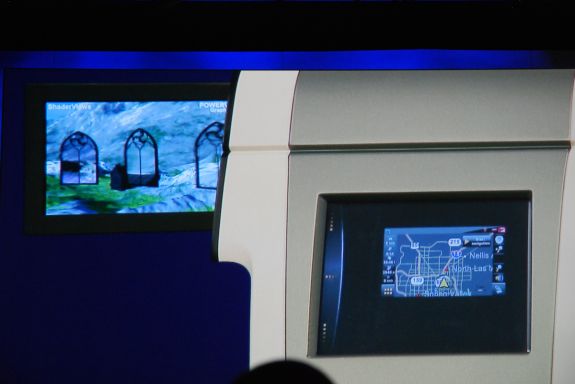
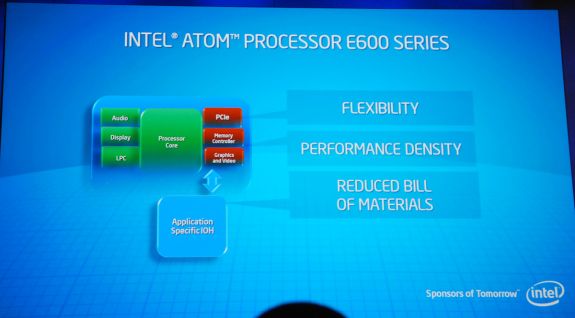
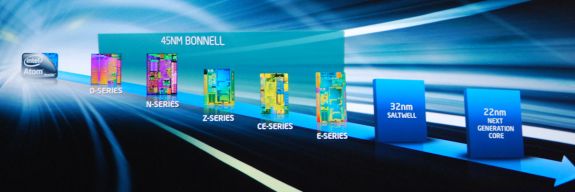
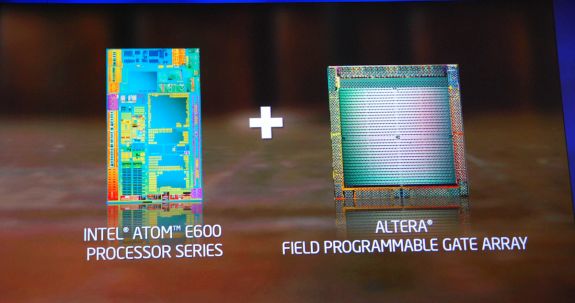
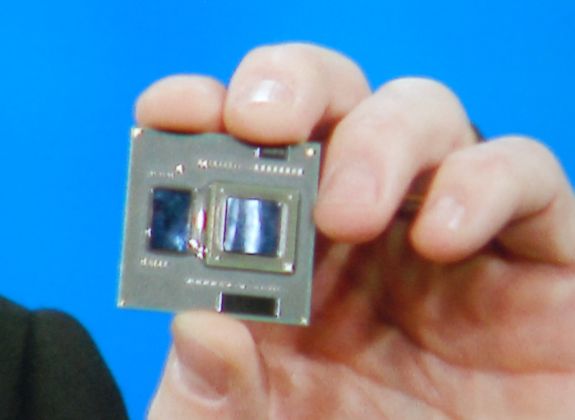
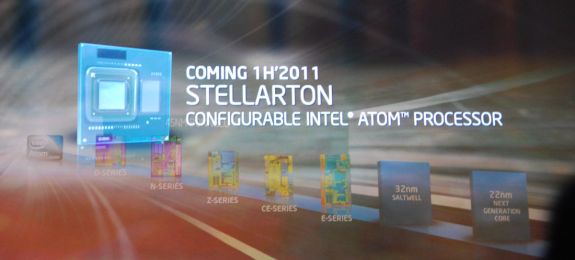








26 Comments
View All Comments
vol7ron - Wednesday, September 15, 2010 - link
Atom's problem is that the software that uses it demands too much. Additionally, didn't someone put together a server with like 1000 Atoms that had some decent results, especially given the power consumption.I'm curious how well Atom performs on Linux machines.
ssj4Gogeta - Wednesday, September 15, 2010 - link
AFAIK they haven't updated the core since it came out. We need to wait for a "tock."submux - Friday, September 17, 2010 - link
This chip is going to cut my development and production costs to next to nothing. Currently, we use Altera FPGAs to connect high speed broadcast video cables to TI DSPs. We don't use x86 because there is just too much glue logic and the power consumption was too high. This chip will allow us to produce boards 1/15th the size of our current design with 1/10th the parts at 1/20th the price.Think of it this way... if you wanted to make a monitoring solution for a broadcast video signal which is transmitted over 3G-SDI (a 2.9[0-9]Ghz coaxial medium). Currently, you'd have to design fancy FPGAs, make your own fancy overlay stuff, deal with audio decoding etc... with this chip, you can make a 5 chip solution which could even perform video analysis.
If you wanted to use a broadcast H.264 signal transmitted over ASI (basically a 270Mbit/sec coaxial link) in the past to do the design you needed either a big FPGA for the decoder or an FPGA and an ASIC to do all that. Now, you can do it with a CPU, RAM and a chip from National Semiconductor or Cirrus Logic.
If they were to add 256Megs of on chip RAM and 32/64megs of on chip flash, the entire design could be done in two chips. Cutting the cost of these devices from $1000 to $100.
The trick is, that now we can add all our glue logic for the SDI and ASI chips into the CPU itself. No need to use an all custom solution. The OS isn't that important, can use any real-time OS that has driver support or hardware documentation. This chip is going to revolutionize the entire broadcast video market.
joker441 - Monday, September 20, 2010 - link
besides this is from xilinx, i'd say this is an even more elegant solution:http://www.linuxfordevices.com/c/a/News/Xilinx-Ext...
but since both of them are not yet available it's hard to say...
dealcorn - Sunday, September 19, 2010 - link
Don't I recall some noise with TSMC over whether they would do funky customized Atoms? Conceptually, are FPGA's used to recapture some of the benefit originally targeted by the TSMC stuff that did not work out? My sense is that Intel knows where they want to go and has a bunch of different initiatives all targeted in the same direction. It is premature to say whether the direction is any good, but they appear to be making a sincere, thoughtful attempt to get there.wazzap123 - Friday, October 7, 2011 - link
You can now run an x86 soft core on low end FPGA.http://www.dailycircuitry.com/2011/10/zet-soft-cor...
Very interesting...